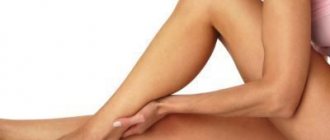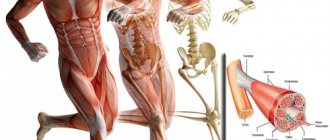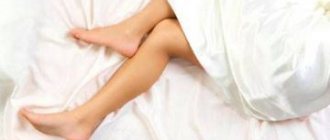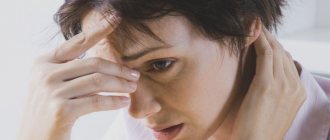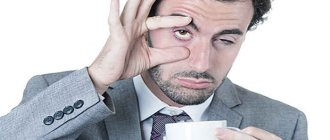Forms and classification of trismus
There are several degrees of trismus of the masticatory muscles:
- mild – the patient can open his mouth 3-4 cm;
- medium – the jaw unclenches by 1-2 cm;
- severe - the mouth opens 1 cm or less.
According to localization, trismus can be:
- unilateral - occurs only on the right or left side, usually appears with injuries and local inflammation;
- bilateral (symmetrical) – occurs in systemic diseases.
The spasm is accompanied by impaired speech and breathing. It also causes significant difficulties with eating.
Popular authors on the metaphysics of diseases about the psychosomatics of clenching the jaw.
Reading the books of psychosomatics adherents, we see that they all agree that the main source of muscle tension in the lower jaw is various forms of anger, malice, and low self-esteem. Louise Hay, popular all over the world, author of the bestseller “Heal Yourself,” explains that the source of the pathology of musculofacial syndrome lies in the patient’s anger, resentment, and his desire for revenge. Repeated use of positive af helps to heal a clenched jaw, the psychosomatics of the disease, according to the author.
The famous doctor and esotericist Luule Viilma claims that the metaphysics of the causes of a clicking and clenched jaw is in an unconscious, vague anger at people or towards oneself and in self-pity. Books: “No harm to yourself” pp. 49, 120; “Stay or Go” p.91; “Forgiveness, real and imaginary” p. 88.
Psychosomatics expert Liz Burbo in her treatise “Your Body Says: “Love Yourself”” sees the cause of jaw clenching, the psychosomatics of pathology in the patient’s suppressed anger, which prevents him from expressing himself correctly. He has lost control of himself and is about to explode. The author believes that the victim needs to “let off steam” as soon as possible, since if there is any delay, there is a possibility of serious damage to his health. Liz Burbo recommends that the patient check how real his fears are, forcing him to restrain his feelings and constantly maintain control over himself. Realize that he has everything he needs to overcome his fears and phobias.
Psychosomatics of a clenched jaw by Dr. R.G. Hamer, the creator of “New German Medicine,” explains the healing crisis within the healing phase when a Special Biological Program of the jaw muscles arises during a motor conflict - it is impossible or impossible to bite, chew, break through, the patient thinks that he needs to fight to break through. And it is precisely when a healing crisis occurs during the recovery phase that spasms of the jaw muscles occur during relaxation.
Trismus makes it difficult to breathe and open your mouth
In most cases, opening the mouth in the situation described above becomes simply impossible without professional help, even with maximum effort, and the person experiences severe pain when trying to unclench his teeth.
This problem may make it difficult to breathe
As a result, breathing difficulties arise, oxygen starvation occurs, speech and the swallowing process are disrupted. With an increase in cases of trismus, in the absence of timely measures to treat it, a person also complains of problems with the digestive tract and stomach, a deterioration in the psychological state, and exhaustion.
When exactly should you see a doctor?
The development of pathological processes with trismus of the jaw is indicated by characteristic signs that require an immediate visit to the dental clinic:
- Reduction of the jaw joints is accompanied by low-grade fever and sometimes nausea.
- Frequent cramps combined with prolonged pain.
- Unilateral spasm with irradiation into the eye on the affected side.
- Sudden attacks of throbbing pain when clenching teeth.
- Swelling of the face on the affected side.
After the examination, the doctor will write a referral for examination.
You may need to visit specialists of a narrow profile - a neurologist, surgeon, otolaryngologist.
Your jaw is cramping - it’s time to seek medical help so as not to further aggravate the situation.
Diagnostics
Trismus is diagnosed based on an external examination of the patient. It is differentiated from a jaw fracture, dental inflammatory diseases, as well as arthrosis of the temporomandibular joint. Since muscle spasm is not a disease, but a symptom, the primary pathology is diagnosed during the examination. To examine the oral cavity, if it is impossible to open the jaw, the patient is given an injection with a drug containing botulinum toxin.
Trismus is diagnosed based on an external examination of the patient. It is differentiated from a jaw fracture, dental inflammatory diseases, as well as arthrosis of the temporomandibular joint.
Since muscle spasm is not a disease, but a symptom, the primary pathology is diagnosed during the examination. To examine the oral cavity, if it is impossible to open the jaw, the patient is given an injection with a drug containing botulinum toxin.
What happens if you don't correct your bite?
It is recommended to correct prognathia of the upper jaw in a child before the age of 14, after which it may be too late. If treatment is ignored, an adult may experience the following complications:
- pathological occlusion or violation of aesthetic facial features - protrusion of the jaw and a reduced shape of the chin provoke complexes associated with appearance, which causes a decrease in self-esteem;
- dysfunction of chewing and swallowing - improper closure of teeth requires a person to put 30% more effort into chewing food compared to the norm;
- diction disorders - the appearance of speech therapy problems.
Also, people with prognathia have an increased risk of developing dental diseases - caries, pulpitis, gingivitis and periodontitis. This is due to a high degree of load on individual areas of the periodontium and teeth.
Pathology can signal dangerous diseases
After attacks, chips on the teeth may occur.
Such a malfunction in the smooth operation of the maxillofacial apparatus may occur due to irritation of the ternary nerve located on the lower jaw. But there are several irritating factors here:
- unskilled dental intervention: for example, with traumatic tooth extraction or with an incorrect injection of anesthetic, after the formation of hematomas. Also, pathology may appear as a result of insufficient preparation for dental implantation, when a specialist selected the wrong implant model without taking into account the condition and quality, density of the patient’s jaw bone tissue,
- the presence of acute, long-term inflammatory processes in the bone tissue of the jaw: periostitis, formation of a gingival hood and long-term pericoronitis over the wisdom tooth, osteomyelitis, phlegmon,
- diseases of the nervous system: hysteria, epileptic seizures, paralysis, neurotic conditions,
- fractures and dislocations of the jaw.
Jaw dislocation may be accompanied by this symptom
Severe trismus of the masticatory muscles can be caused by neuralgia of the ternary nerve, various injuries and jaw fractures. That is why, if you have such a problem as a sharp, involuntary clenching of the jaws, you should immediately consult a doctor. Every minute is precious also because the disease can not only lead to difficulty breathing and the inability to eat properly, but also be a signal of a cerebral hemorrhage, the presence of meningitis, oncology, stroke, tetanus or rabies.
Why the jaw cramps - reasons
There are many reasons for spasms of the facial muscles; it is provoked by internal and external factors.
Internal factors are features of the human condition, pathologies of various organs, in particular:
- brain pathologies – cancer, hemorrhages;
- anatomical defects of the musculoskeletal system;
- some diseases - rabies, tetanus;
- nervous system disorders - depression, hysteria;
- false bulbar palsy.
Problems of the oral cavity and lower jaw can cause spasms of the masticatory muscles:
- dental procedures;
- facial injuries – fractures, jaw dislocations;
- arthritis of the lower jaw joint;
- trigeminal neuralgia;
- inflammation, soft tissue abscesses, periosteum.
Trismus is often observed in people suffering from bursitis and leading a busy life with stress and nervous tension.
Another provocateur for the development of hypertonicity of the muscles of the lower jaw is playing sports - barbells, diving with constant efforts to hold the mouthpiece in the mouth.
Home treatment for trismus
These methods can be used to treat trismus at home, but only after consultation with a dentist and/or neurologist and determining the root cause of the spasm.
- Massage. Massaging the jaw joints and chewing muscles helps relieve pain. It is worth knowing that the muscles are located on the descending processes and on both sides of the lower jaw, and the temporomandibular joint is opposite the auricle. Experts recommend performing massage using only a small amount of force. Using the tips of your middle and index fingers, move along your cheek and try to feel the tender area of your jaw. It needs to be massaged for about half a minute. The pressure should be gentle and sufficient to relax the muscles and relieve pain;
- Thermal impact. Heat helps relax muscles by relieving spasms and increasing blood circulation. You can fill a bottle with warm water or use a hot compress, which must be applied to the painful area for half an hour. Do not use a compress that is too hot to avoid burns;
- Cooling effect. Alternating warm and cooling effects is an excellent home therapy for trismus of the masticatory muscles. Low temperatures relieve inflammation and reduce pain. 5-10 minutes after removing the hot compress, experts recommend applying cold, then replacing it again with warm action;
- Relaxation. Constant stress is an important influencing factor in the development of lockjaw. Experts recommend that before a relaxation session, find a comfortable and quiet place where you will not be disturbed by external stimuli. Here you can sit or lie down, relax, closing your eyes. You should breathe deeply and evenly, imagining yourself in a pleasant place and noting all its beneficial little things, for example, the calm but clean aroma of the surrounding places, silence and birdsong, the sound of leaves or the sea surf. This exercise should be performed for several minutes, after which it is recommended to open your eyes, continuing to breathe evenly and deeply;
- Meditation or yoga. Meditation allows a person to get rid of the burden and problems of everyday life, relax his soul and body, and clear his head of unnecessary thoughts and questions. Yoga allows you to restore spiritual harmony, it helps a person get to know his body and causes a feeling of peace, tranquility and happiness. Even 15 minutes of meditation or yoga a day can change a person’s life; in addition, such practices perfectly relax muscles.
We emphasize that this can only be done after consulting a doctor, otherwise you can only harm yourself. So, if you have lockjaw, you can alleviate your condition using the following methods:
- Massage: Gently massage the areas around the lower jaw. On the left and right, just below the ears, you can effectively relax the muscles if you press them with your index and middle fingers without unnecessary effort for thirty seconds,
- take a painkiller tablet: if you can open your mouth, which is possible in mild stages of the disease, then you can take Nurofen or Nise, as well as other anesthetics that suit you from your home medicine cabinet. A painkiller tablet will help alleviate the condition
- Applying heat or cold: Some experts advise alternating cold and hot compresses, but you need to be especially careful here. Cold will have a good anesthetic effect and relieve symptoms of inflammation, but do not overdo it, otherwise tissue necrosis will not be avoided. Heat increases blood circulation and can lead to relief, but it is contraindicated if there is a purulent focus,
- relaxation: you need to try to find a secluded place and relax. It’s good if you can lie down and normalize your breathing, close your eyes and even meditate.
If a muscle spasm occurs in a patient due to improperly provided dental intervention, due to untreated caries or periostitis, as well as due to jaw injuries, then doctors usually give favorable prognoses: with timely assistance, the condition usually returns to normal after 1-3 weeks. But if you postpone treatment for a long time until later, then this period may not be limited. The more time passes, the more difficult trismus is to treat.
In situations where systemic diseases are to blame, treatment will take much longer. Well, the most unfavorable prognosis is in conditions when trismus occurs as a harbinger of rabies or tetanus - in such cases there are even deaths. That is why always be on guard of your health and sound the alarm even if your health deteriorates slightly. Also, do not forget to vaccinate your children, yourself and pets against these terrible diseases.
Reasons for development
Triggers that cause muscle spasm are divided into two types - general and local.
Common reasons why trismus occurs:
- neoplasm or tumor of the brain;
- intracranial hemorrhage;
- diseases - pseudobulbar palsy, stroke, epilepsy, cerebrospinal meningitis;
- in dentistry - consequences of anesthesia or treatment, malocclusion;
- anatomical features - spinal defects, uneven leg lengths;
- psychosomatic disorders - neurosis, stress, depressive states.
Local factors provoking spasm:
- injuries - fractures, dislocation (or subluxation of the jaw);
- cellulitis or abscesses in the facial area;
- inflammation of the periosteum, bone or soft tissues, for example, osteomyelitis or pericoronitis, formed due to the removal or growth of a wisdom tooth;
- chronic bruxism (clenching or grinding of teeth during sleep);
- infectious processes;
- inflammatory foci - trigeminal nerve, arthrosis (arthritis), advanced pulpitis or caries.
READ Causes and treatment methods for jaw cysts
Practicing doctors believe that the main triggers of muscle spasm are the following factors:
- incorrectly installed orthodontic structures, unsuccessful prosthetics;
- diseases of a neurotic nature;
- chronic psycho-emotional stress - often occurs in people who have professions associated with increased responsibility and risk.
In addition to all of the above, trismus is typical for people whose activities are related to professional sports - scuba divers or divers squeezing a mouthpiece in their mouths, or weightlifters experiencing extreme muscle tension in a snatch.
Also, muscle hypertonicity sometimes occurs when taking a contrast shower or dousing with cold water. This may be a sign of developing rabies or tetanus. To avoid the occurrence of a source of infection, such diseases must be vaccinated in advance.
Prognosis and prevention
Trismus of the lower jaw, which occurs after anesthesia, as a result of inflammatory processes in the oral cavity or trauma, has a favorable prognosis. In most cases, the functions of the masticatory muscles are restored within 1-3 weeks.
With systemic diseases, the chances of full recovery are lower. The worst prognosis for rabies is that the disease almost always ends in death. In order to prevent trismus, it is necessary to promptly eliminate inflammatory foci in the oral cavity, vaccinate against tetanus and rabies, and prevent injuries and stressful conditions.
With systemic diseases, the chances of full recovery are lower. The worst prognosis for rabies is that the disease almost always ends in death.
In order to prevent trismus, it is necessary to promptly eliminate inflammatory foci in the oral cavity, vaccinate against tetanus and rabies, and prevent injuries and stressful conditions.
Spasm of the lower jaw
The most common cause of spasm of the lower jaw is a previous injury. When dislocated or fractured, the teeth of the lower jaw may move. This leads to unpleasant sensations when chewing.
To detect an injury, you need to check for swelling at the site of the impact.
Also, after a bruise, a sharp pain occurs when you press on the jaw. It manifests itself on the right or left, the intensity of pain depends on the injury itself.
There are more serious reasons for the occurrence of lockjaw. Chronic pain can cause the growth of cancerous tumors. In order to correctly diagnose the problem, you should contact your dentist. The doctor will conduct an examination, order an x-ray and begin to fix the problem.
There are different degrees of trismus
If you or someone around you has a spasm of the mandibular muscles, it is important to check whether the victim is able to open his mouth. If he manages to open it by 3-4 centimeters, then doctors later talk about a mild degree of damage. If it is only 1-2 centimeters, this indicates an average degree of development of the disease. When it is impossible to open the mouth, a severe pathology is diagnosed.
Most often, trismus is bilateral - it occurs against the background of neurology and damage to various infections. Less commonly, unilateral - occurs against the background of an inflammatory process in the bone tissue of the jaw. In the second case, the patient's face becomes distorted, the jaw moves to one side. At the same time, the muscles become hard, “stony” to the touch, and swell. It is important to differentiate pathologies from a jaw fracture or arthrosis.
The occurrence of a cyst of the lower jaw
A jaw cyst is a cavity in the jaw bone that is filled with fluid or pus. Caused by infection in the dental tissue. Very often the cyst does not cause discomfort and develops asymptomatically.
During the inflammatory process, the disease is accompanied by the following symptoms:
- swelling;
- redness at the site of occurrence;
- numbness in the corners of the mouth;
- facial asymmetry;
- limited mouth opening;
- mobility of an inflamed tooth;
- difficult nasal breathing.
The formation of a cyst requires contacting a dental surgeon. After a complete diagnosis, surgery is performed to eliminate the pathology. Untimely treatment can lead to destruction of bone tissue.
Tongue thrust and tongue size
Parafunctional tongue thrusting is an abnormally strong pressing of the tongue against the teeth during swallowing. When swallowing, a load of approximately 0.4-7.0 N/cm2 is recorded in the anterior and lateral areas of the palate. For orthodontic tooth movement, a constant load of only a few N/cm is sufficient. There are 8 different types of tongue thrust, but the most common ones are anterior and posterior unilateral, and posterior bilateral. The question is often asked, which comes first - aberrant tongue position or poor dental alignment? Regardless, this condition may contribute to the development of complications during implant healing or affect the longevity of the prosthesis. Although the tongue thrust force is less intense than other parafunctional forces, it is horizontal and can increase the amount of stress in the gingival portion of the implant. Analysis of this force is most important for single-stage surgical techniques in which the implant is in an elevated position upon initial placement and the implant contact area is in the early healing phase. Tongue thrusting can also cause the incision line to become exposed and cause soft and hard tissue damage.
Tongue thrusting can cause tooth displacement or mobility, which is significant, especially if the implants are located in the same quadrant. If natural teeth in the tongue thrust area have been lost as a result of abnormal tongue position or movement, then the implants are at increased risk during initial healing and early loading of the denture.
To assess anterior tongue thrust, the examiner pulls the patient's lower lip down, holds it in that position, and asks the patient to swallow. Normally, when swallowing, a vacuum is created in the patient's mouth due to the position of the tongue in the front of the palate. A patient suffering from anterior tongue thrust cannot create the vacuum required for swallowing because sealing is achieved by the lower lip. To assess posterior tongue thrust, the cheeks are pulled away from the back teeth one at a time with a mirror, and the examiner asks the patient to make a swallowing movement. Visually discernible movement of the tongue during swallowing may also be accompanied by pressure on the instrument, which confirms the presence of lateral force. Posterior tongue thrust may occur in patients who wear a maxillary denture and have a Kennedy Class I mandibular arch without a prosthesis to replace these teeth. Under these conditions, the maxillary denture often weakens the valve seal and collapses at the rear because only the anterior teeth are in contact. To reduce this problem, the patient places the back of the tongue in the edentulous area to prevent displacement of the maxillary denture.
The tongue often fills the available space and its size may increase as teeth are lost. As a result, a patient who does not wear a mandibular denture often has a tongue that is larger than normal. The installation of implants and prosthetic teeth in the mouth of such a patient leads to an increase in the magnitude of lateral forces, which can be long-lasting. In addition, the patient complains of a lack of space for the tongue and may bite it while chewing. A mistake on the part of the prosthetist would be to reduce the width of the lingual contour of the mandibular teeth. The lingual cusp of restored mandibular posterior teeth should follow the Wilson curve and have proper horizontal overlap to protect the tongue during occlusion. Reducing the width of the back teeth often increases the frequency of tongue biting, which may not improve over time. It is necessary to make a prosthesis that corresponds to such conditions, and not treat them as a short-term inconvenience. The prosthetist should determine the position of the tongue before treatment and inform the patient about the need to teach correct tongue movements.
Methods for treating malocclusion
In the true form of prognathia, correcting the patient’s malocclusion is accompanied by certain difficulties. If a teenager or adult has already formed a permanent bite, in most cases correction by surgical intervention is recommended, since the pathology is often combined with other equally serious diagnoses, for example, deep bite.
Orthopedic methods are practically useless in case of formed prognathia. Only in a small number of patients can prognathia be masked by removing individual molars and long-term wearing of braces.
- activator tools that stimulate the growth of the lower jaw and interfere with the development of the upper jaw row;
- pressure bandages that prevent the process of bone tissue growth;
- Frenkel apparatus, which gives the jaw an anatomically correct structure.
Surgical correction of prognathia is based on cutting the jaw tissue and directing it to the side at an angle at which the teeth begin to fit together correctly. After this, splints are applied to the bone elements, and after 2 months they are expected to heal. After the end of the rehabilitation period, the patient is diagnosed with a physiological occlusion, and his facial features in most cases become more aesthetic.

